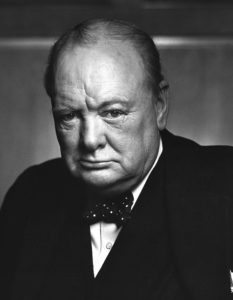A preliminary study of Winston Churchill’s least favorite painting will go to auction at Sotheby’s later this year.
When we think of famous portraits of Winston Churchill, the first one that comes to mind is the 1941 photograph by Yousuf Karsh, often called The Roaring Lion. It shows the prime minister as both dignified but also hardened, which is very appropriate for a world leader in the midst of a world war. The story goes that Churchill’s expression is because Karsh snatched the cigar out of his mouth after refusing to put it down. Modern audiences, however, might remember a different portrait of Winston Churchill, one painted by the modern British painter Graham Sutherland.
Parliament commissioned a portrait from Sutherland in honor of Churchill‘s eightieth birthday in November 1954. Some may be familiar with the painting since its creation was the subject of the ninth episode of season one of the Netflix series The Crown. John Lithgow won the Emmy for Outstanding Supporting Actor in a Drama Series for his portrayal of Churchill in the episode.
At the time, Sutherland was one of Britain’s top contemporary artists; originally part of Britain’s Neo-Romantic movement along with Paul Nash and Ivor Hitchens, with his abstract landscapes being his specialty. His most well-known work, however, would come after the Second World War. He cemented his position as a leading artist with his 1946 painting The Crucifixion at St. Matthew’s Church in Northampton. The vicar, Walter Hussey, commissioned Sutherland at the recommendation of Henry Moore, who created a Madonna and Child sculpture for the church. Sutherland is said to have used photographs taken at Nazi concentration camps as references when creating the painting. By the late 1940s, he was also receiving commissions for portraits, including those of writer Somerset Maugham, politician and newspaper owner Lord Beaverbrook, gallerist Arthur Jeffress, and music critic Edward Sackville-West.
Winston Churchill had sat for portraits by several great artists at that point, including John Singer Sargent and Walter Sickert. So imagine his surprise when he saw the finished portrait for the first time, which was at its unveiling in Westminster Hall. Churchill was very self-conscious of his image and believed Sutherland’s portrait made him look decrepit and oafish. The painting’s admirers, however, saw Sutherland’s portrayal of the former prime minister not in a negative way but as a man weary from years of service to the country. His voice was dripping with sarcasm when he described the final portrait as a “remarkable example of modern art”. In private, Churchill described it as “filthy and malignant,” making him look like “a down-and-out drunk who has been picked out of the gutter in the Strand”; he never came to appreciate the portrait. Churchill’s wife Clementine hid it in the cellar of their home at Chartwell. Scholars generally agree that within a year of Churchill bringing the Sutherland portrait home, it was destroyed. Some say that Clementine took it into their yard and set it on fire, while others claim that Churchill’s private secretary, Grace Hamblin, did it.
During the portrait’s creation, Sutherland made a series of sketches and oil studies, which the artist later gave to the art dealer Alfred Hecht. One study belongs to the Ogilvy family, an aristocratic Scottish clan who are also King Charles III’s cousins. It differs from the final portrait in that it is only a bust-length portrayal in three-quarter view, with the former prime minister appearing a bit lost in thought. The Ogilvy family has consigned the study to Sotheby’s, where it will appear at the June 6th Modern British & Irish Art Evening Sale in London. Sotheby’s specialists estimate it will sell for between £500K to £800K. Before then, it will be on display at Sotheby’s New York location as well as Churchill’s birthplace at Blenheim Palace.

